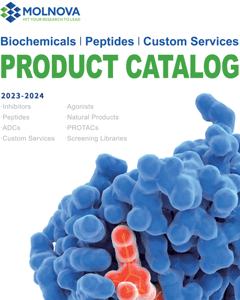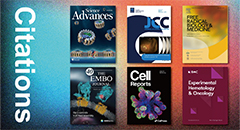
GLP-2(1-33)(human)
CAS No. 223460-79-5
GLP-2(1-33)(human)( GLP-2 (human); Glucagon-like peptide 2 (human) )
Catalog No. M29856 CAS No. 223460-79-5
GLP-2(1-33) (human) is an enteroendocrine hormone which stimulates the growth of the intestinal epithelium.
Purity : >98% (HPLC)
 COA
COA
 Datasheet
Datasheet
 HNMR
HNMR
 HPLC
HPLC
 MSDS
MSDS
 Handing Instructions
Handing Instructions
| Size | Price / USD | Stock | Quantity |
| 5MG | 851 | Get Quote |


|
| 100MG | Get Quote | Get Quote |


|
| 200MG | Get Quote | Get Quote |


|
| 500MG | Get Quote | Get Quote |


|
Biological Information
-
Product NameGLP-2(1-33)(human)
-
NoteResearch use only, not for human use.
-
Brief DescriptionGLP-2(1-33) (human) is an enteroendocrine hormone which stimulates the growth of the intestinal epithelium.
-
DescriptionGLP-2(1-33) (human) is an enteroendocrine hormone which stimulates the growth of the intestinal epithelium.(In Vitro):GLP-2-treated group demonstrates a 518±22% increase (P<0.05) in mucosal IGFBP-4 mRNA levels as compare with vehicle-treated controls. Because the mucosal expression of IGFBP-4 transcripts is found to be very low relative to that of the whole intestine, FRIC cultures are used as an in vitro model of the entire intestine. FRIC cultures have previously been established to express a functional GLP-2 receptor (GLP-2R) that displays a cAMP response, as well as enhances IGF-1 mRNA expression and IGF-1 secretion in response to GLP-2 treatment. When incubates with GLP-2 (10?8 M) for 2 hours, IGFBP-4 mRNA expression in the FRIC cultures is also found to be increased, by 40.8±15.2% (P<0.05), compare with vehicle-treated cells.(In Vivo):GLP-2 quickly increases apoB48 mass in the TRL fraction of plasma, which is indicative of chylomicron number, and this is blocked by L-NAME. GLP-2 treatment alone increases postprandial TRL-lipids (slope 3.65±0.73×10?3 g/L/min vs 1.63±0.28×10?3 g/L/min, GLP-2 vs control), and this effect is completely mitigated by L-NAME pretreatment (slope 3.67±0.15×10?4 g/L/min). The GLP-2-induced rise in TRL-apoB48 occurres within 30 minutes and precedes the rise in TRL-TG. GLP-2 acutely increases plasma tritium levels (slope, 1.66±0.25×102 dpm/mL/min vs 1.11±0.17×102 dpm/mL/min, GLP-2 vs control).
-
In VitroGLP-2-treated group demonstrates a 518±22% increase (P<0.05) in mucosal IGFBP-4 mRNA levels as compare with vehicle-treated controls. Because the mucosal expression of IGFBP-4 transcripts is found to be very low relative to that of the whole intestine, FRIC cultures are used as an in vitro model of the entire intestine. FRIC cultures have previously been established to express a functional GLP-2 receptor (GLP-2R) that displays a cAMP response, as well as enhances IGF-1 mRNA expression and IGF-1 secretion in response to GLP-2 treatment. When incubates with GLP-2 (10?8 M) for 2 hours, IGFBP-4 mRNA expression in the FRIC cultures is also found to be increased, by 40.8±15.2% (P<0.05), compare with vehicle-treated cells.
-
In VivoGLP-2 quickly increases apoB48 mass in the TRL fraction of plasma, which is indicative of chylomicron number, and this is blocked by L-NAME. GLP-2 treatment alone increases postprandial TRL-lipids (slope 3.65±0.73×10?3 g/L/min vs 1.63±0.28×10?3 g/L/min, GLP-2 vs control), and this effect is completely mitigated by L-NAME pretreatment (slope 3.67±0.15×10?4 g/L/min). The GLP-2-induced rise in TRL-apoB48 occurres within 30 minutes and precedes the rise in TRL-TG. GLP-2 acutely increases plasma tritium levels (slope, 1.66±0.25×102 dpm/mL/min vs 1.11±0.17×102 dpm/mL/min, GLP-2 vs control).
-
SynonymsGLP-2 (human); Glucagon-like peptide 2 (human)
-
PathwayGPCR/G Protein
-
TargetGlucagon Receptor
-
RecptorGLP-2 receptor
-
Research Area——
-
Indication——
Chemical Information
-
CAS Number223460-79-5
-
Formula Weight3766.19
-
Molecular FormulaC165H254N44O55S
-
Purity>98% (HPLC)
-
SolubilityIn Vitro:?H2O : 25 mg/mL (6.64 mM)
-
SMILES——
-
Chemical NameSequence:His-Ala-Asp-Gly-Ser-Phe-Ser-Asp-Glu-Met-Asn-Thr-Ile-Leu-Asp-Asn-Leu-Ala-Ala-Arg-Asp-Phe-Ile-Asn-Trp-Leu-Ile-Gln-Thr-Lys-Ile-Thr-Asp
Shipping & Storage Information
-
Storage(-20℃)
-
ShippingWith Ice Pack
-
Stability≥ 2 years
Reference



-
des-His1-[Glu9]-Gluc...
Glucagon receptor antagonist (pA2 = 7.2 for inhibition of glucagon-induced adenylyl cyclase activation in rat liver membranes); displays no agonist activity. Enhances glucose-stimulated pancreatic insulin release in vitro. Blocks added glucagon-induced hyperglycemia in normal rabbits without affecting glycogenolysis in vivo. Also blocks endogenous glucagon-induced hyperglycemia in streptozocin diabetic rats.
-
HAEGTFTSD
HAEGTFTSD is the first N-terminal 1-9 residues of GLP-1 peptide.The GLP-1 (7-36) amide is a product of the preproglucagon gene, which is secreted from intestinal L-cells, in response to the ingestion of food.
-
V-0219
V-0219 is a positive allosteric modulator of GLP-1 and can be used in studies about obesity-associated diabetes.



 Cart
Cart
 sales@molnova.com
sales@molnova.com


